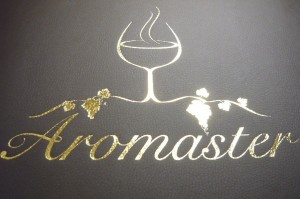Having received a floor model of the Aromaster wine aromas kit from the manufacturer, I played with it a bit at first, and now I’m enjoying delving into it more intensely.
The Aromaster kit is a collection of 80 little bottles that fit into numbered slots on the inside of a square, brown briefcase. Each bottle is also numbered, and contains one of the component scents in wine. The aromas are divided into sections like wood scents, floral, fruits, vegetal and mineral aromas, etc.
The key to the scents is listed in a separate little booklet. So you can open any bottle, and try to guess what the aroma is. It even has one of those 1 player board games that comes with it. (I haven’t gotten that far, yet.) Very entertaining, as well as educational for a wine professional—or a great gift for a guy-who-has-everything—it costs €270 ($380 USD).
I had wanted to try a scent kit ever since I took a course at CIA Napa and realized that not everyone smells the same thing in the same wine. And we’re all highly suggestible.
 Last summer, touring the Finger Lakes with a group of mainly British journalists (I’m from the US) I found that childhood memories also play a significant role in identifying scents. The hardest one for the UK contingent to grasp was what Americans call “grapey,” the super-sweet fruit flavoring of purple lollipops and purple grape juice that we all grew up on. Well, the British didn’t. They grew up on a fruit drink concentrate called Ribena, which has an equally sweet black currant flavor.
Last summer, touring the Finger Lakes with a group of mainly British journalists (I’m from the US) I found that childhood memories also play a significant role in identifying scents. The hardest one for the UK contingent to grasp was what Americans call “grapey,” the super-sweet fruit flavoring of purple lollipops and purple grape juice that we all grew up on. Well, the British didn’t. They grew up on a fruit drink concentrate called Ribena, which has an equally sweet black currant flavor.
Aromaster is a British-oriented tasting model, and it doesn’t have a “grape” bottle. I guess that’s OK, because I know what grape smells like. On the other hand, it does contain scents I am not familiar with—in addition to black current—like red currant, hawthorn, linden, and acacia. Always more to learn.
As a longtime cookie-baker, I did pretty well in the “oak-ageing” category with scents like nutmeg, cinnamon, and almond. And I did respectably on the woods, too—though “oak” smelled like plywood to me, and “pine” was more like the pungent, pine-scented cleaner I remember from summer camp. A few more of the aromas in the bottles reminded me strongly of things from my past—and not necessarily the scents they were supposed to. “Honeysuckle” evoked a great-aunt’s face powder. And “cherry” took me straight back to sticky cough syrup.
 Have you gotten the idea that this is fun? It’s a grown-up guessing game. The answers are there if you want them, and not if you don’t. I’m trying not to look, this week.
Have you gotten the idea that this is fun? It’s a grown-up guessing game. The answers are there if you want them, and not if you don’t. I’m trying not to look, this week.
And incidentally, this is making me better at my job. At a wine tasting this afternoon, I found myself working on picking out the different notes of fruit and flowers in the wines, not just jotting down terms like “sweet” or “floral.”
Tomorrow, I return to the row of little bottles with the scents of faults in wine—also important, I keep reminding myself.
 Becky Sue Epstein is Palate Press’s International Editor. An experienced writer, editor, broadcaster, and consultant in the fields of wine, spirits, food, and travel, her work appears in many national publications including Art & Antiques, Luxury Golf & Travel, Food + Wine, and Wine Spectator. She began her career as a restaurant reviewer for the Los Angeles Times while working in film and television.
Becky Sue Epstein is Palate Press’s International Editor. An experienced writer, editor, broadcaster, and consultant in the fields of wine, spirits, food, and travel, her work appears in many national publications including Art & Antiques, Luxury Golf & Travel, Food + Wine, and Wine Spectator. She began her career as a restaurant reviewer for the Los Angeles Times while working in film and television.
